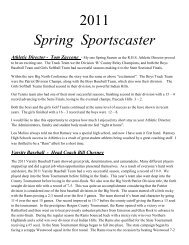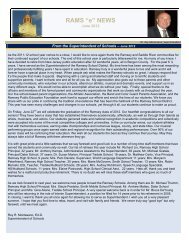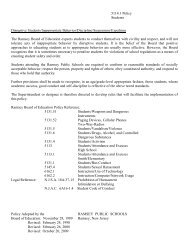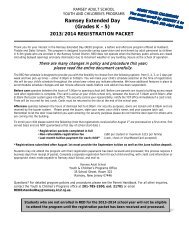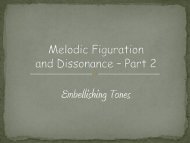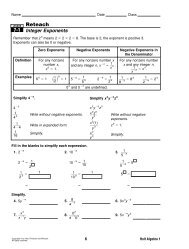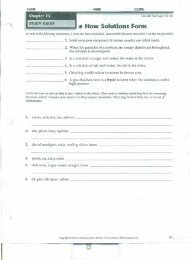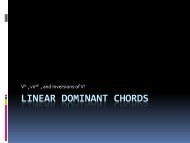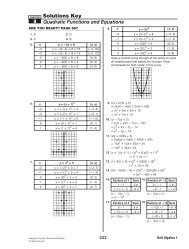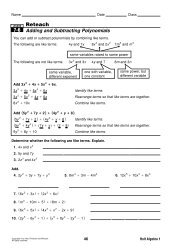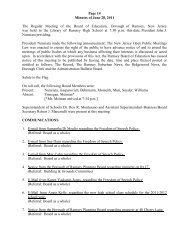Pre-Algebra Chapter 6 - Ramsey School District
Pre-Algebra Chapter 6 - Ramsey School District
Pre-Algebra Chapter 6 - Ramsey School District
Create successful ePaper yourself
Turn your PDF publications into a flip-book with our unique Google optimized e-Paper software.
Practice and Apply<br />
Homework Help<br />
For<br />
Exercises<br />
See<br />
Examples<br />
12–34, 1, 2<br />
35, 36 3<br />
37 4<br />
Extra Practice<br />
See page 739.<br />
A spinner like the one shown is used<br />
in a game. Determine the probability<br />
of each outcome if the spinner is<br />
equally likely to land on each section.<br />
Express each probability as a fraction<br />
and as a percent.<br />
12 2<br />
11 3<br />
10 5<br />
9 8<br />
12. P(8) 13. P(red) 14. P(even)<br />
15. P(prime) 16. P(greater than 5) 17. P(less than 2)<br />
18. P(blue or 11) 19. P(not yellow) 20. P(not red)<br />
There are 2 red marbles, 4 blue marbles, 7 green marbles, and 5 yellow<br />
marbles in a bag. Suppose one marble is selected at random. Find the<br />
probability of each outcome. Express each probability as a fraction and<br />
as a percent.<br />
21. P(blue) 22. P(yellow) 23. P(not green)<br />
24. P(purple) 25. P(red or blue) 26. P(blue or yellow)<br />
27. P(not orange) 28. P(not blue or not red)<br />
29. What is the probability that a calendar is randomly turned to the month of<br />
January or April?<br />
30. Find the probability that today is November 31.<br />
Suppose two spinners like the ones<br />
shown are spun. Find the probability<br />
of each outcome. (Hint: Make a table<br />
to show the sample space as in<br />
Example 2 on page 311.)<br />
31. P(2, 7) 32. P(even, even)<br />
33. P(sum of 9) 34. P(2, greater than 5)<br />
1 2<br />
4 3<br />
5 6<br />
8 7<br />
www.pre-alg.com/self_check_quiz<br />
DRIVING For Exercises 35 and 36, use the<br />
following information and the table shown.<br />
The table shows the approximate number of<br />
licensed automobile drivers in the United States<br />
in a certain year. An automobile company is<br />
conducting a telephone survey using a list of<br />
licensed drivers.<br />
35. Find the probability that a driver will<br />
be 19 years old or younger. Express the<br />
answer as a decimal rounded to the nearest<br />
hundredth and as a percent.<br />
36. What is the probability that a randomly<br />
chosen driver will be 40–49 years old? Write<br />
the answer as a decimal rounded to the nearest<br />
hundredth and as a percent.<br />
Age<br />
Drivers<br />
(millions)<br />
19 and under 9<br />
20–29 34<br />
30–39 41<br />
40– 49 37<br />
50–59 24<br />
60–69 18<br />
70 and over 17<br />
Total 180<br />
Source: U.S. Department of Transportation<br />
Lesson 6-9 Probability and <strong>Pre</strong>dictions 313



